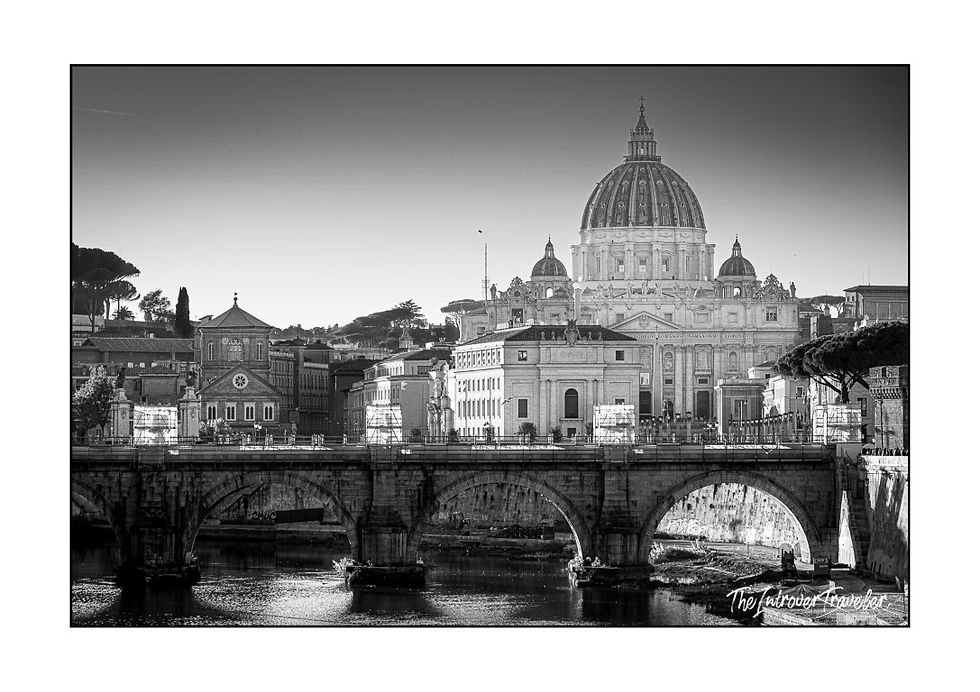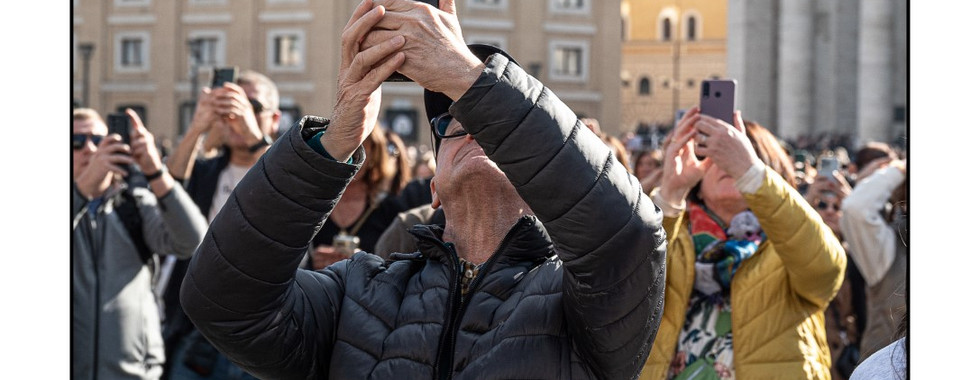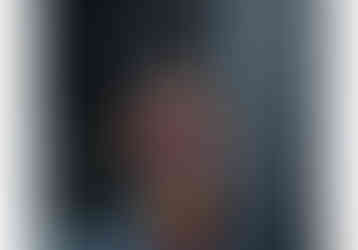Rome, the Vatican, the Pope, St. Peter's Square and the Angelus
- The Introvert Traveler
- May 10
- 4 min read
Updated: May 10

Date of visit : November 2024
Visit duration : 4 hours (including the visit to St. Peter's)
My opinion : agnostic
Attending Pope Francis' Angelus (one of Bergoglio's last, in November 2024) in St. Peter's Square in Vatican City is not just a religious experience: it is a perfect choreography of baroque architecture, liturgical theater and diverse humanity that flows like a river into the great ellipse designed by Gian Lorenzo Bernini. A morning at the Angelus does not begin with the appearance of the Pontiff: it begins much earlier, between checks, waits and a slow but inexorable flow of bodies and intentions.

Access and security measures for the Angelus in St. Peter's Square
Access to St. Peter's Square is guarded like an airport in times of maximum alert. The gates generally open around 7:30, even though the Angelus is held at noon. You have to go through metal detectors, empty your bags and backpacks and wait under the watchful eye of the Carabinieri and the State Police, with some camouflage uniforms to remind you that, here too, faith is mixed with fear.
Once you have passed the security checks, you finally enter the heart of Catholic Christianity. St. Peter's Square presents itself as an open-air theater show, where everyone looks for their best place, often standing for hours, others sitting on the pavement or on the steps.
The majesty of architecture
What makes the wait bearable is the magnificence of the place. Bernini's embracing colonnade is perhaps one of the highest forms of symbolic urbanism ever conceived: 284 columns and 88 pillars that simulate the arms of the Church open to the world. Looking up gives a sense of order and immensity, amplified by the symmetry that unfolds 360 degrees.
The façade of St. Peter's Basilica, with its gigantic statues of the Apostles and the mighty Michelangelo dome, dominates the scene. It is a symphony of travertine and marble that vibrates under the light of the Roman sun, dappled by the reflections of the multicolored robes of pilgrims, religious people and tourists. Bramante, Michelangelo, Bernini: it is as if the entire visual theology of the Counter-Reformation had come together to explain Catholicism without using a single word.
Everything is of titanic proportions and thinking about the effort put into the creation of this work, among the most audacious of humanity, leaves you speechless.

The wait for the Angelus and the big screens
The wait for the Angelus is punctuated by voices in many languages, by improvised songs. The giant screens placed on the sides of the square broadcast the mass celebrated inside the basilica. Many follow it with participation, others watch it as if they were watching a reality show, looking for the perfect shot of the Pope.
Around 11:45, the collective gaze turns toward the window of the papal apartment, on the third floor of the Apostolic Palace. Shortly after, the red flag is displayed, anticipating the appearance of the pontiff.

The vatican and the Apparition of the Pope
At noon sharp, the window opens. Pope Francis appears, greets, smiles, raises his hand. The crowd erupts in a roar that is more like a rock concert than a liturgical event. Selfies start simultaneously. Some cry. Almost everyone films compulsively. The Pope begins his speech: simple words of peace, social justice, and faith.
And yet, while he speaks, there are those who continue to fiddle with their smartphones, those who comment out loud, those who light a cigarette, those who exchange sandwiches and bottles of water. One part of the crowd is there with authentic devotion, the other seems to be participating in a pop cultural ceremony rather than an act of faith. There is the lady in the Hello Kitty t-shirt next to the praying nun; the scout group next to the influencer with the tripod.
The diverse people of San Pietro
Here is what is most striking: the human mosaic. Filipinos on a parish trip, Americans on a pilgrimage, Italians who came on the diocesan bus. Many seem to have stepped out of a time machine stuck in the 80s. Others are wrapped in flags, caps with visors and printed T-shirts. It is an anthropological microcosm where religion is only one of the vectors of identity.
The Swiss Guards attract glances and lenses: they seem to have come out of a Renaissance film, with their halberds and martial bearing. The Carabinieri observe silently, often immobile for hours. Every now and then you notice a Monsignor crossing the square in a hurry, perhaps headed for a more urgent task than the salvation of souls.

Conclusion of the Angelus and entrance into the Basilica
The Pope ends with the Angelus formula and the blessing. Another round of applause follows, another burst of flashes and videos. Then the window closes and the atmosphere relaxes. Some begin to flow out, others head toward the entrance of the Basilica, which is opened to the public shortly after.
The flow is imposing but orderly. The central nave welcomes the people on their way to the altar, the Confession of Peter, the Bernini baldachin and, for the most motivated, the dome. Inside, the volume of the world is lowered. The marble, the gold and the silence seem to take back the scene.
A copy of the Vatican Pietà (under restoration) is offered for selfies by tourists, who cannot see the difference with the original .
A disenchanted reflection
And yet, despite everything, despite the beauty, the history and the symbolic power of the place, I can't help but feel that the whole experience resembles more a perfect staging than an authentic contact with the divine. As if one were inside an episode of The Office directed by Fellini.
The feeling, more than mystical, is that of witnessing the impeccable functioning of a colossal communication machine. The "Pope Francis" brand works wonderfully: empathy, smile, carefully constructed simplicity. But the doubt remains: how much of all this is ecclesiastical marketing and how much is faith?
It feels like being at the center of a two-thousand-year-old advertising campaign, with testimonials dressed in white and a transgenerational fan base. Ultimately, more than the presence of God, in that moment and in that place you perceive the absolute triumph of faith in the narrative, and the still intact power of the longest-running branding operation in human history.
Amen. Or maybe: add to cart.























































Comments